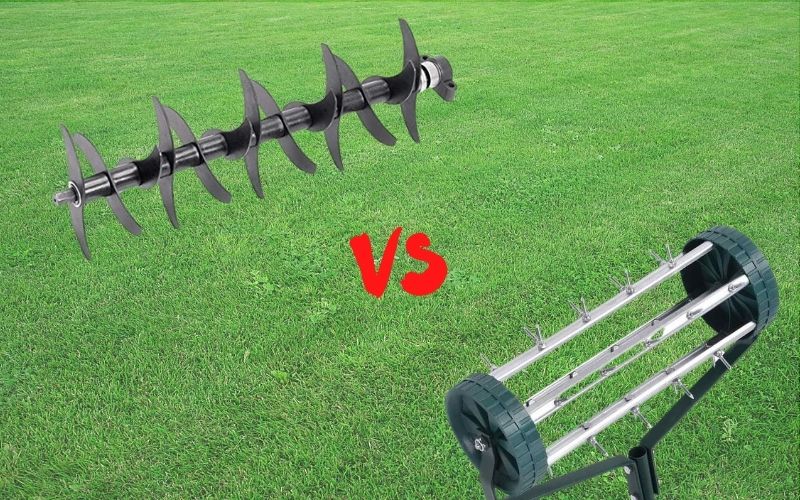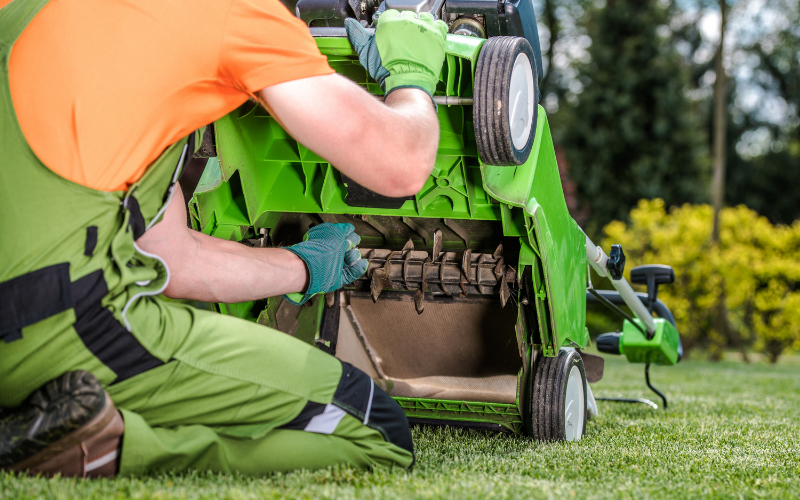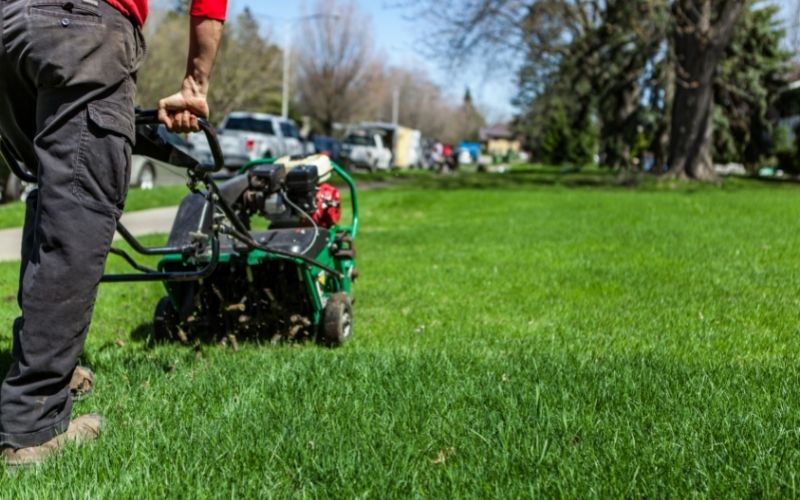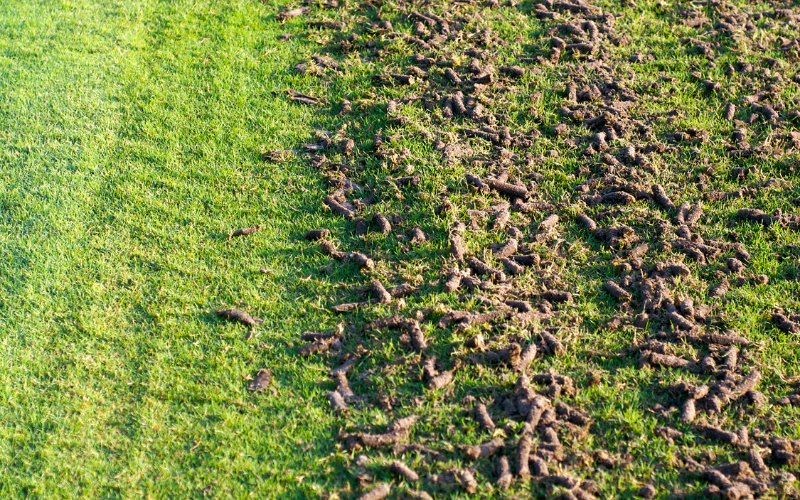Even though scarifiers and aerators both tackle what’s under your lawn in an attempt to make improvements, they’re actually performing two completely different jobs.
So, understanding what each tool does and how it can help is key when choosing which tool to grab from the shed.
So, what’s the difference between a scarifier vs aerator? Let’s find out.

Scarifier vs. Aerator (The Short Answer)
The purpose of a scarifier is to remove excessive thatch buildup that acts as a barrier from the top of the soil surface.
On the other hand, an aerator is designed to penetrate the soil beyond the surface to reduce soil compaction.
The common factor between the two tools is that they both aim to improve the grass’s access to water, nutrients, and air exchange.
| Scarifier | Aerator |
|---|---|
| Removes Thatch | Reduces Soil Compaction |
| Scarifier Uses Blades | Aerator Uses Cores/Spikes |
| Average Working Depth 0-1 inch | Average Working Depth 0-6 inch |
| Allows Elements to Reach the Soil Surface | Allows Elements to Penetrate the Soil |
Scarifier Vs Aerator: A Closer Look
Now let’s take a closer look at both aerators and scarifiers and see how they work and what makes them so different.
What is a Scarifier?

A scarifier is basically an aggressive dethatcher that uses a series of blades attached to a rotating drum that cuts into the thatch.
Now because the thatch on a lawn is only at the very top of the soil, the metal cutting blades only need to be a few inches long.
As the drum rotates, the blades cut into the thatch and tear most of it out.
After a couple of passes with a scarifier set to the correct height across your lawn, you should be able to reduce the thatch to an acceptable level where it will no longer cause any problems.
What is an Aerator?

An aerator’s job is to puncture the soil to alleviate the effects of soil compaction.
Compaction is where the soil compresses so much that water, nutrients, and air find it too difficult to travel down through the soil.
Therefore, to overcome soil compaction, you either need to break up the soil or create channels down through the soil.
Now, unless you want to tear up your lawn with a cultivator, an aerator is going to be the best option.
Aerators are available in many different designs ranging from handheld tools to mechanical machines.
The main difference in the tools is that some are easy to use and work best in larger areas, while others demand more physical strength and are meant for small sections.
Also, depending on the specific tool you choose, the penetration depth will vary as some larger machines aerate much deeper.
The Main Difference Between the Scarifying and Aerating Processes
To recap: the main difference between a lawn scarifier vs. aerator is that a scarifier tackles thatch, whereas an aerator manages soil compaction.
So even though the tools can sometimes look and work similarly, they are actually taking care of two different issues.
How do you know which tool you should use? Let’s take a look.
How to Know Which Tool You Should Use
To figure out whether you should use a lawn scarifier vs an aerator, you’ll need to inspect your soil and thatch and see what’s going on.
After a quick investigation of the ground beneath your lawn, you should get a pretty clear idea of whether you need to scarify vs aerate or if you need to do both tasks.
When You Should Scarify Your Lawn (+ Signs It’s Necessary)
A few telltale signs that indicate your lawn needs to be scarified include excessive dead grass sitting under the new grass blades, a spongy feeling when you walk over your lawn, or even your lawn staying wet and becoming boggy long after watering.
Even though these are all pretty trustworthy signs that scarifying is needed, they also tell you that the thatch has already become excessive.
If you monitor your thatch situation closely, you may be able to just dethatch rather than scarify.
I find the best way to determine if you need to scarify vs dethatch is to check the soil and measure the thatch thickness periodically.
If the thatch is less than ½ inch, then a good dethatching may be enough, but if the thatch is more than ½ inch, you’ll definitely want to break out the scarifier.
When You Need to Use an Aerator
Determining whether you need to aerate is similar to figuring out if you need to scarify. In other words, you can wait to notice the signs you need to aerate or take a proactive approach.
For example, thin patches of grass, standing water, and yellowing grass are all signs that a lawn might be suffering from soil compaction. However, this approach allows soil compaction to become an issue.
Instead, regularly checking your soil by doing a quick test with a screwdriver or a similar metal spike should give you a pretty good idea of how compact your lawn soil is.
For example, if the screwdriver goes into the soil easily, then the soil likely isn’t compacted. But if the screwdriver is hard to push in, your soil is compacted and could benefit from aerating.
There are special devices available to give accurate compaction readings, but I find a screwdriver from my toolbox works just fine.
The Benefits of Scarifying and Aerating
There are many benefits to scarification vs aeration, which happen to be the same or at least very similar.
Let’s review what they are.
| Benefits of Using a Scarifier | Benefits of Using an Aerator |
|---|---|
| Improved nutrient absorption | Enhanced nutrient absorption |
| Enhanced water penetration | Better water absorption and drainage |
| Increased air circulation & exchange | Increased air circulation & exchange |
| Enhanced overseeding effectiveness | Enhanced effectiveness of overseeding |
| Prevention of disease and pests | Reduces soil compaction |
| Better weed control | Enhanced overall lawn health |
| Improved overall lawn health & appearance | Improved appearance |
Is It Best to Scarify or Aerate a Lawn – or Should I Do Both?

It goes without question that both aeration and scarifying when carried out individually, can have huge benefits on any lawn. But this doesn’t mean you have to either scarify or aerate.
Instead, you can carry out both jobs and notice greatly improved results on your overall lawn’s health.
First, I recommend you check the soil composition and thickness of thatch before you start. But it’s pretty safe to say that aerating and scarifying your lawn at least once a year is an acceptable minimum.
Typically, doing both jobs in the spring and then again in early fall is a standard approach for the average lawn.
When in doubt, all you really need to remember is that scarifying takes care of the top of the soil, and aeration takes care of the lower soil.
Therefore performing both tasks one after the other will take care of all the soil under your lawn and help your grass absorb all the water, air, and nutrients it needs to be in tip-top shape.



Hi! Looking at thatching my lawn . I live in south jersey 50’s to 70’s this time of year . Is it too late to thatch and power seed?
Hi Nina! I personally would not recommend seeding a lawn after mid-October in South Jersey. Though it’s warm right now, you do want a good 6 weeks for the lawn to become established before there is a consistent dip below 55F. At 55F or below, the grass will go dormant and stop growing. If this happens in the first 3 to 4 weeks of the growing process, the grass is unlikely to survive the rest of the cold season. A full 6 weeks ensures cold survival. It is, however, safe to thatch your lawn now in preparation for seeding the lawn as soon as it gets warm in the spring. Hope this helps 🙂
I just had my lawn aerated and am expecting to scarify shortly. How long should I wait between aerating to scarifying? I left the plugs on the grass and to my understanding, want to leave them as they are good for it (is that accurate?). If I don’t want to pick those up with the scarifying attachment on my cylinder mower, how long should I wait?
Hi Kellen,
Yes, leaving the plugs on the lawn is ideal as they do no harm and will break down into nutrients for your lawn over time. These plugs should fully break apart in as little as one week and may do so faster after a heavy rain or watering session. You can find more information about what to do with plugs or cores after aeration in this post.
If it were me, I would allow it to rain once or water my lawn deeply once and then wait an additional 48 hours before scarifying. This should allow the plugs to break down and dry out enough so that they won’t stick.
I hope that helps 🙂
Hi, I live in New York City area with a small lawn 700sq ft. I have a tall type fall fescue lawn newly seeded in Sept 2021? After the winter I see some bare spots on lawn and I plan to do overseeding this fall. I have a couple of questions. 1) Since I have a small lawn so is it ok to do a manual core aeration this fall season (one yr after) and then overseed? 2) After aeration can I leave plugs on lawn and spread seeds on top of plugs and core holes for germination? Will the plugs on lawn damage the existing grass? 3) do I need to put starter fertilizer or compost on top of overseeds? 4) do you recommend to mix blue grass with tall fescue in the overseed?
Thanks
Hi Gary,
It sounds like you have a solid plan. Yes, overseeding in the fall would be appropriate. You could either do so after aerating right at the end of summer with just enough time for the seeds to sprout and take hold or wait until after your first frost.
If you have a relatively flat yard: What I would recommend is to aerate about a month before your first estimated frost date. Then allow the cores to “dissolve” for the next 3 to 4 weeks. They should not damage the existing grass. Once your first frost date has passed, if temperatures are as low as they should be, then overseed. These seeds should stay dormant all winter and will “wake up” to sprout with the rest of your lawn in the early spring.
You may add a slow-release fertilizer or compost to the seed mixture or after you overseed in the late fall/winter but this is not necessary. Adding compost the following spring, shortly after germination, would be ideal.
I would not recommend mixing fescue and bluegrass together in most cases. If you aren’t completely happy with the fescue you have now, I would look for an improved variety. If, however, the problem is that you have too much shade on your lawn, overseeding with bluegrass could help fill in any “in progress” bare spots.
Let me know how you get on 🙂
I thought that scarifying and dethatching were two different procedures. I saw a video on Sun Joe dethatcher and scarifier and assumed that the scarifying procedure was to loosen the soil as an aerator would. Can you enlighten me on those different procedures?
Hi Jonathan!
You’re correct that scarifying, dethatching, and aerating are all different procedures. But, their methods are somewhat related. All three of them involve removing material from your lawn in order to give it access to proper light, water and nutrients.
However, while aerating is done in order to help loosen the soil itself, scarifying and dethatching are done to remove built-up grass clipping and debris that sits on top of the grass. This is why you might see a 2-in-1 scarifier/dethatcher.
Scarifying digs a bit deeper into the grass than dethatching does, but they both are done to remove thatch. I’ve also written a piece on using a scarifier vs dethatcher if you’re looking for some more detail on those procedures.